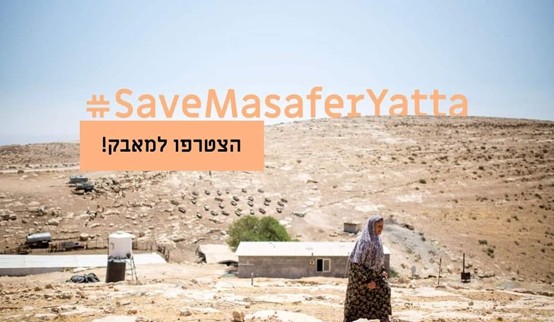Israel’s Supreme Court has held on Tuesday a hearing over an attempt to displace more than 1,300 Palestinians from a rural part of the occupied West Bank that the Israeli army has designated for military exercises. The army wants to demolish eight small communities in a rocky area of the southern West Bank near Hebron.

Residents in eight villages in the area of Masafer Yatta in the southern Hebron Hills, have been in danger of eviction for two decades due to the declaration of the area as “Firing Zone 918,” will be decided in the High Court of Justice (HCJ).
For about two decades, the residents of the Palestinian villages in the South Hebron Hills have been living under threat of home demolitions, evictions, and dispossession. The occupation army declared their area of residence a firing zone, and in 1999 issued eviction orders claiming that those dwelling there were not permanent residents, forcing them to leave. This order completely ignored the unique way of life of these communities, including their ancient agricultural culture and the clear historical documentation indicating generations of Palestinian settlement in these villages, from when they were cave-dwelling until today. The eviction of residents from the area means the demolition of these historic villages and the displacement of entire families, including children and elders, in direct violation of Israel’s obligations to the Palestinian population under its control, both under international and Israeli law.
Since January 2000, the Association for Civil Rights (ACRI) has been accompanying the residents in their legal fight against eviction by filing a petition following their eviction from their villages. In March 2000, the HCJ heard ACRI’s petition (and a similar petition by Adv. Shlomo Lecker), and issued an interim order that allowed the residents to temporarily return to their homes, banning the army from evacuating them in the meantime. The order is still in force, and thus the residents continue to live in their villages today until further notice.
In January of 2013, ACRI filed an amended petition, which will be addressed tomorrow, as over the years, there have been numerous hearings concerning various State proposals on the matters. The essence of these proposals is permanent: Palestinians living in the area will be forced to evacuate a significant portion of the area for extended periods, including during the agricultural season, to allow the IDF to train.
Following the previous hearing on the amended petition in July of 2017, the HCJ had issued an order nisi, requiring the State to submit an alternative minimal training plan. In its response, the IDF insists that the petition be dismissed and the petitioners evicted from the area, but following the court’s decision, the IDF issued a training plan according to which the army requires that many of the petitioners evacuate their homes for several hours whenever there is a day of training. Every month would be held some 2-4 trainings, each training lasting 4-5 days. Each training furthermore would affect the residents of 3 or 4 villages. The army noted that this is the most limited training format and that the number and scope of training is expected to increase.
So far, the army has not explained why the area is essential for its needs in the West Bank, and why it is not possible to make alternative use of the vast firing zones in Israel, other than for budgetary considerations. The establishment of a firing zone in a populated area of the Occupied Territories violates International Humanitarian Law, and the attempt to forcibly dislocate residents is a serious violation of the laws of military occupation.
The petitioners submitted to the court a document that the Akevot Institute for Israeli-Palestinian Conflict Research located in the Israel State Archives in Jerusalem: A 1981 transcript of a meeting in which Ariel Sharon, who was then serving as Minister of Agriculture, suggested that military representatives set up training areas in the South Hebron Hills in order to dispossess Palestinian residents of the area from their lands. Sharon explained that the government has an interest in the presence of the army in these areas given the “the rural Arabs expand [their settlements] from the hill ridge towards the desert.” Sharon’s proposal was turned into an official decision.
The petitioners had also submitted a legal opinion from 1967 by Meir Shamgar, then the Military Advocate General, according to which the expulsion of residents of Masafer Yatta for training purposes constitutes a violation of Article 49 of the Geneva Convention, and agricultural cultivation is sufficient reason to forbid declaring the area a firing zone. On August 2020, another hearing was held on the petition, and at the end the court clarified that it preferred that a compromise be reached between the parties. At the beginning of February 2021, the army conducted a large military exercise in the area, during which a large number of military equipment (thirty tanks and a convoy of heavy trucks) passed through the village of Jinbeh and caused damage to property. Subsequently, the petitioners submitted an urgent request for the court to issue an interim order refraining from such training, and, in response, the army undertook not to conduct such training pending the ruling on the petition.
On February .2021, the village council of Masafer Yatta submitted a request to join the proceedings as Amicus Curiae. Presented in the request were an additional collection of testimonies, affidavits, documents and historical, geographical, architectural and archeological analyses that reveal the history of the villages and further explain the history of continuous and permanent settlement of the Masafer Yatta communities since the British Mandate to the present day.
More on Masafer Yatta: https://maki.org.il/en/?s=Masafer+Yatta+


